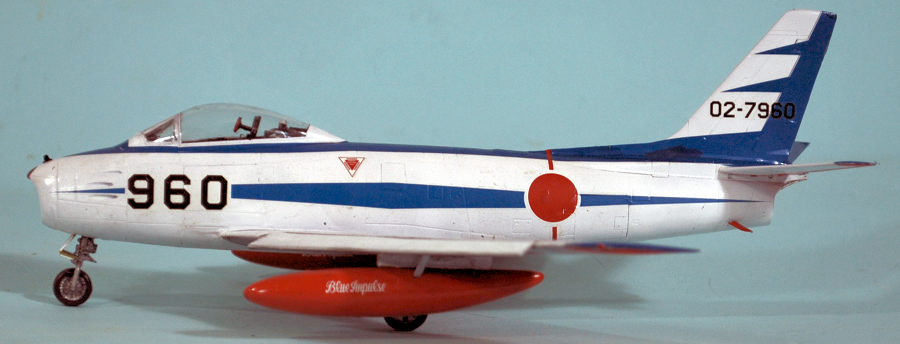
| KIT #: | A08115 |
| PRICE: | $52.00 |
| DECALS: | Two options |
| REVIEWER: | Tom Cleaver |
| NOTES: | Hasegawa decals |

| HISTORY |
During the Korean War, the F-86 Sabre had been outperformed by the MiG-15 with regard to altitude performance. The MiG’s operational ceiling of 50,000 feet allowed the Soviet fighters to almost always use an altitude advantage when attacking a Sabre formation. This problem was partially solved with the F-86F and the adoption of the “6-3" wing, which provided a slight altitude advantage, but at the cost of low-speed handling when the new wing leading edge replaced the slats that deployed at low speed for control. The lack of leading edge slats exacerbated a dangerous and often fatal handling characteristic upon take-off if the nose were raised prematurely from the runway, known as “over rotation,” in which the nose comes up high enough to stall the wing if it does not have slats. The 1972 Sacramento Sabre accident resulting in 22 fatalities and 28 other casualties was a result of over-rotation on take-off leading to a stall and crash.
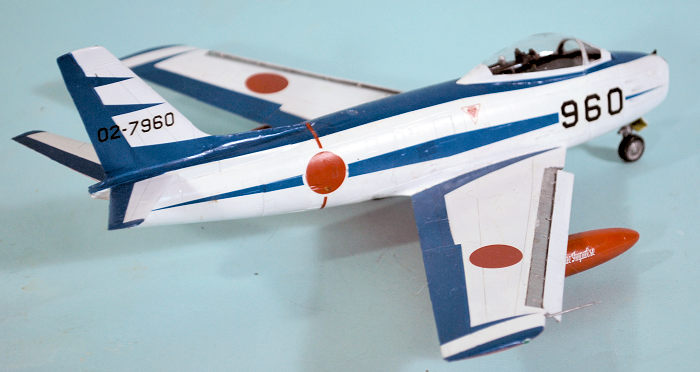 Production
of the F-86F Sabre finally ended with the delivery of the last F-86F-35-NA in
August 1954. However, with U.S. allies and NATO air forces desiring the Sabre as
a result of its Korean War record, the USAF found it impossible to meet its
commitments to allies such as Nationalist China and Japan and NATO by using the
surplus F-86Fs. Consequently, the F-86F was put back into production to meet
this demand.
Production
of the F-86F Sabre finally ended with the delivery of the last F-86F-35-NA in
August 1954. However, with U.S. allies and NATO air forces desiring the Sabre as
a result of its Korean War record, the USAF found it impossible to meet its
commitments to allies such as Nationalist China and Japan and NATO by using the
surplus F-86Fs. Consequently, the F-86F was put back into production to meet
this demand.
The new model was known as the NA-227 by North American and the F-86F-40-NA to the USAF. A contract for 215 was formally signed on June 27, 1955. A further 65 were added to the contract on March 27, 1956, with two additional production runs in 1957 resulting in a total 580 F-86F-40s produced. None of these were intended for USAF service and all were paid for with MDAP funds.
The first F-86F-40-NA (serial number 55-3816) rolled out of the factory in October 1955. The new F-86F-40 was basically similar to the earlier F-86F Sabres and was powered by the same J47-GE-27; it had the fuselage, weapons system, and flight controls of the standard F It was the ultimate expression of the day-fighter Sabre, and resolved both the altitude question by extending the wing tips, increasing wing area from 302.3 sq ft to 313.4 sq ft and wing span from 37.12 ft to 39.11 ft. The wing reintroduced wing slats, while keeping the 6-3 wing planform. The wing slats and the increased wing area markedly improved handling, especially at low speeds. The low-speed roll-and-yaw problem which had plagued the "6-3" F-86F Sabres was largely eliminated. Stalling speed was reduced from 144 mph to 124 mph, and the takeoff ground run was reduced 800 feet. Maximum speed was 678 mph at sea level, 599 mph at 35,000 feet; climb rate was 8,100 fpm with 30,000 feet reached in 5.2 minutes.
These improvements in handling and turning ability led the USAF to upgrade many of their existing F-86F-25 and F-86F-30 Sabres to F-86F-40 standards. North American supplied modification kits containing the new wing leading edge, slat assemblies, wingtip extensions, and new ailerons. Many Sabre-equipped foreign air forces also upgraded their Sabres to F-40 standards through use of these kits. Only Canadair and Commonwealth Sabres were not equipped with F-40 wing kits, although both could accept the installation. Additionally, the F-86D interceptor was modified with this wing, becoming the F-86L.
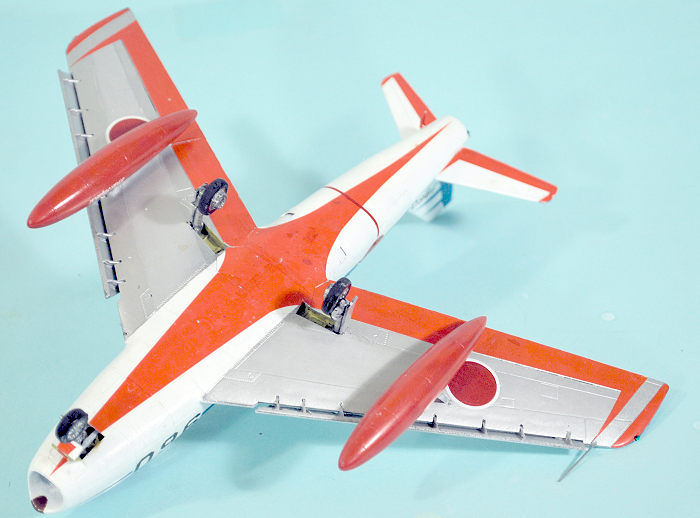 In
late 1953, Japan was allowed to reconstitute its military forces, though they
were to be defensive only, which was confirmed in their titles using “Self
Defense”. The new Japanese Air Self-Defense Force chose the F-86 for its initial
equipment. 300 F-86F-40s were built by Mitsubishi Heavy Industries in a joint
production agreement with North American Aviation signed on July 13, 1954.
In
late 1953, Japan was allowed to reconstitute its military forces, though they
were to be defensive only, which was confirmed in their titles using “Self
Defense”. The new Japanese Air Self-Defense Force chose the F-86 for its initial
equipment. 300 F-86F-40s were built by Mitsubishi Heavy Industries in a joint
production agreement with North American Aviation signed on July 13, 1954.
Mitsubishi did not manufacture the Sabres from scratch. Kits made by North American were sent to Japan for assembly. This included 70 NA-231 sets, 110 NA-238 sets, and 120 NA-256 sets. The first Mitsubishi-assembled Sabre flew on August 9, 1956, with the last completed on February 25, 1961. In 1960, the aircraft were modified with pylons to carry the Philco-Ford GAR-8 (AIM-9B) Sidewinder AAM. Mitsubishi’s experience with the Sabre formed the basis of the creation of the modern Japanese aviation industry.
The Blue Impulse Flight Demonstration Team:
In 1959 the USAF Thunderbirds visited Japan and inspired JASDF commanders to establish an official aerobatic team. In 1960, the new team was formed at Hamamatsu airbase flying five F-86Fs of 2nd Squadron.
The first demonstration of the "Tenryū" team, named after the Tenryū River near the air base, occurred on March 4, 1960 at Hamamatsu. The team name was found to be hard to pronounce in western languages, so it became the Blue Impulse. They were equipped with smoke generators using different colors for each aircraft: white, red, blue, green and yellow. In 1961 the aircraft received a special paint scheme of overall white with blue flashes.
In 1964, Blue Impulse performed at the opening ceremony of the 1964 Summer Olympics in Tokyo, drawing the Olympic rings in the air with colored smoke. With our ship being in port in Yokosuka, I was in Tokyo visiting Japanese friends that week, and we went to that Olympic opening. One could walk up on opening day and get seats about midway in the stands of the stadium, which turned out to be very good for viewing a flight routine I have remembered since.
In February 1982, after 545 air demonstrations, Blue Impulse replaced their Sabres with Mitsubishi T-2 trainers. Today they fly the Kawasaki T-4.
| THE KIT |
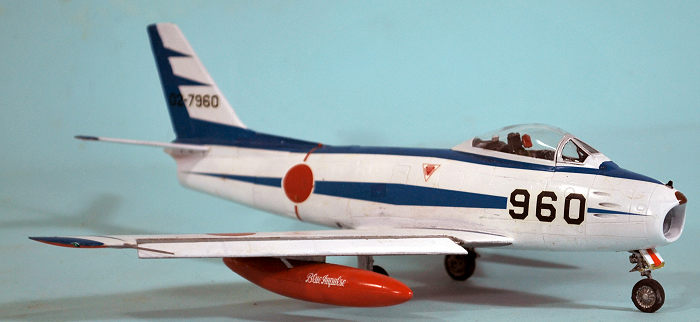 Airfix’s
announcement a few years ago that they would produce a Canadair Sabre Mk.4 was
initially met with enthusiasm by modelers, since the Mk. 4 is an F-86E, produced
with narrow-chord wings and slats. At last! An early F-86 would be available as
a kit rather than as a project using expensive resin replacement parts.
Enthusiasm turned to disappointment when the kit was released as an upgraded Mk.
4 with the 6-3 wing and no slats. The fact the kit overall was not one of
Airfix’s best, being clunky in parts design with a fictional cockpit did not add
to sales.
Airfix’s
announcement a few years ago that they would produce a Canadair Sabre Mk.4 was
initially met with enthusiasm by modelers, since the Mk. 4 is an F-86E, produced
with narrow-chord wings and slats. At last! An early F-86 would be available as
a kit rather than as a project using expensive resin replacement parts.
Enthusiasm turned to disappointment when the kit was released as an upgraded Mk.
4 with the 6-3 wing and no slats. The fact the kit overall was not one of
Airfix’s best, being clunky in parts design with a fictional cockpit did not add
to sales.
This year, Airfix released the F-86F-40, which did not bring forth great enthusiasm. I will admit to being one of the less-enthused, but when the review kit arrived curiousity got the better of me and I opened it up.
It’s definitely not one of Airfix’s better kits. It is clunky like their Bf-109E, with even-heavier panel lines. It does, however, have wing slats that can be displayed extended. The cockpit was as poor as advertised. The clear parts have that now-standard annoyance of being pulled from the mold too soon, wrecking their clarity. The kit decals are nice, providing the option of either a Royal Norwegian Air Force F-86F-40 or a JASDF fighter.
Since I happened to have two of the Hasegawa F-86F-40 Blue Impulse limited editon kits, I decided I would see if it was possible to create a Blue Impulse Sabre with the kit. As it turns out, one can.
| CONSTRUCTION |
 I
started by assembling the wing. There are two leading edge part options for
slats open or closed. I tried fitting the slats tp the open leading edge and the
fit was awful. I was able to get the slats to fit by filing the rail openings in
the leading edge a bit wider and narrowing the rails. I then fitted the wing.
The way this is designed, with the outer extended wingtip and aileron as a
separate part, if the similar part in the Mk. 4 kit was substituted, one would
by 95% of the way to a Canadair Sabre Mk. 6; it would be nice if Airfix was to
do this, since the mix-and-match would be easy and the only other item needed
would be to replace the lower cooling intakes on this with the “sugar scoops.”
The fact those intakes are separate insert parts leads me to think Airfix may
already have thought of this.
I
started by assembling the wing. There are two leading edge part options for
slats open or closed. I tried fitting the slats tp the open leading edge and the
fit was awful. I was able to get the slats to fit by filing the rail openings in
the leading edge a bit wider and narrowing the rails. I then fitted the wing.
The way this is designed, with the outer extended wingtip and aileron as a
separate part, if the similar part in the Mk. 4 kit was substituted, one would
by 95% of the way to a Canadair Sabre Mk. 6; it would be nice if Airfix was to
do this, since the mix-and-match would be easy and the only other item needed
would be to replace the lower cooling intakes on this with the “sugar scoops.”
The fact those intakes are separate insert parts leads me to think Airfix may
already have thought of this.
The cockpit and seat are junk; I threw them away and used the Hasegawa cockpit and seat, with the Airfix rear area under the canopy. I had determined this would have the canopy closed, which meant what could be seen through the distorted canopy would be fine.
I used “cannonball” fish weights in the nose to get nose-sitting. I modified the landing gear wells so I could use the “gear door retracted” option for the main gear doors while having the wheels down, which would make applying the marking decals easier.
Overall, the kit assembles easily and with care in assembly I did not need any filler anywhere.
| COLORS & MARKINGS |
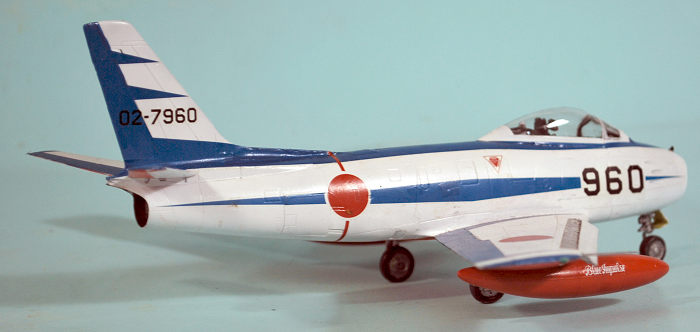 I only
needed to paint the lower wing in aluminum and the overall white color for the
rest. I did the aluminum first, using Vallejo Aluminum, with White aluminum for
the wing center section, then masked that off. I painted the rest of the model
with Tamiya X-2 Gloss White. I painted the 200-gal drop tanks X-3 Gloss Red with
a bit of X-5 Orange to get an approximate match between them and the red
markings on the underside of the model.
I only
needed to paint the lower wing in aluminum and the overall white color for the
rest. I did the aluminum first, using Vallejo Aluminum, with White aluminum for
the wing center section, then masked that off. I painted the rest of the model
with Tamiya X-2 Gloss White. I painted the 200-gal drop tanks X-3 Gloss Red with
a bit of X-5 Orange to get an approximate match between them and the red
markings on the underside of the model.
Fortunately I had two sheets of the Blue Impulse markings, which helped because the Hasegawa kit and Airfix kit differ just enough that there were some gaps when I laid down the main markings, which I was able to hide using pieces from the second sheet.
Once the model was painted and decaled, the “too heavy” surface detail looked better, the same way the Airfix Bf-109E looks better once painted and decaled.
I unmasked the canopy and attached the landing gear and drop tanks.
| CONCLUSIONS |
The model has grown on me since it was finished. From 18 inches away, it looks nice and can sit next to a Hasegawa Sabre. It’s a nice addition to my Sabre collection, and if Airfix does the smart thing and reissues the kit with mix-and-match parts so a Sabre 6 can be done, I would definitely get one. (As a note, Tom has told me the kit does not include the rather prominent intake scoop on the right side of the fuselage, so you cannot do a proper Japanese F-86 with what is in the box. Ed)
6 October 2022
Copyright ModelingMadness.com. All rights reserved. No reproduction in part or in whole without express permission.
Review kit courtesy of Hornby USA.
If you would like your product reviewed fairly and fairly quickly, please contact the editor or see other details in the Note to Contributors.